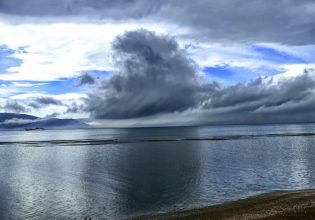An environmental crime in Drapetsona and «strange» links to an economic scandal in the US
How Oil One polluting facilities in Drapetsona are related to the company associated with businessman Dimitris Melissanidis
For decades the residents of Drapetsona have been struggling to get rid of the environmentally burdensome industrial facilities in their area and to transform what used to be the site of a fertilized plant into a recreational and cultural centre.
On these seaside tracts since the childhood years of the great composer-singer-bouzouki player Markos Vamvakaris, beyond the well-known factory that emitted radioactive phosphogypsum one had the abattoir of Drapetsona where the composer had worked.
Then there followed the glassmaking units as well as the cement industry and fuel facilities.
In 1997, almost a century after the establishment of the first industry there was a sense of light at the end of the pollution tunnel. With decisions that changed the general city plan of the Municipality of Drapetsons the fertiliser factory area was characterised as an area slated for remodeling.
With the fertiliser factory having closed and most industrial activities having declined there was a hope that something might change, that after many years and the cessation of pollution in the area, the revitalisation and growth of the coastal front of Drapetsona would constitute one of the most important challenges and opportunities with critical economic, social, and environmental repercussions for Piraeus and all of Attica. Mr Melissandis is a defendant in a class action suit
Why the plans did not progress
Ten years later, the hopes of residents who did not see the plans progressing revived.
Then environment minister Yorgos Souflias and merchant marine minister Manolis Kefalogiannis at a press conference presented the proposal for that remodeling and the creation of an international nautical centre and two marinas and the development of zones for cultural development, athletics, recreation, hotels, and residences.
However things did not evolve in this manner despite the fact that industrial activity in the area had collapsed.
At the end of the decade of 2,000 the facilities in the fertiliser area were minimal.
Most appeared abandoned including those belonging to BP.
Why are the plans not progressing?
It is because as of 2015 to this day residents have lodged hundreds of complaints regarding smelly materials because the previous year the area was set aside as an oasis at the edge of the port.
Why in just the last year did EKEFE Dimokritos register 69 days of incidents out of a total of five playoff facilities that it has placed in the area?
Prefectural reports
The answers gradually unfold as of 2012 and thereafter in a series of coincidences which indicate a facilitation of interests.
In October, 2012, BP’s facilities were acquired by Dimitris Melissanidis’ Oil One and a month later the Attica prefectural council opined positively about the creation of a mineral oil production unit and about the storage-movement of liquid fuel.
In July of the following year the same organ opined positively about the amendment of environmental terms of establishment so that Oil One could receive, store, and transport fuel, mix and package fertilisers, and process liquid fuel refuse.
One month later, in August, 2013, the Decentralised Administration of Attica approved the environmental terms.
Yet the area during this period was characterised as an “Area of remodeling” and that was a problem because based on the plan all industrial activity had to move out of Drapetsona.
However in April, 2014, by decision of environment minister Yannis Maniatis the city plan changed from an area to be remodeled into an area of “metropolitan intervention” allowing industrial, light industry, and tertiary sector activity.
The average building zone structure factor increased from 0.4 to 0.6.
In August, 2014, the new regulative plan included the ratification of the “metropolitan intervention” and the characterisation “Industrial Port Zone of Drapetsona” which referred to industrial and light industry use of the area.
In January, 2015, deputy environment minister Asimakis Georgiou issued a permit for the operation of Oil One and thus Dimitris Melissanidis’ company was able to operate in Drapetsona.
Licensing before 2015 elections
“Due to the serious responsibilities of the New Democracy-Pasok government on 21 January, 2015, four months before the elections we saw the licensing of a new unit in the area.
Enter Oil One
Our new visitor is Oil One. It is in operation since 2015 and processes petroleum products “70 metres” from our yards” To Vima was told by Keratsini-Drapetsona Mayor Christos Vrettakos.
“When a person calls me at midnight and tells me, “Mayor it smells and I cannot breathe” what shall I do? What would any environment minister do in an organised state operating under the rule of law where the paramount value is the health of the people?”
Complaints about the stench from local residents began in 2015. Various scenarios were examined such as the possibility that it came from Psyttaleia, which was dismissed after checks.
The sub-prefecture of Piraeus requested data on the facilities of the waste processing centre facilities. In the reply it appears that there had not been changes since 2015 and thereafter that might have triggered such “episodes”.
Another scenario was that the odour came from Elefsina but that was ruled out in the Dimokritos study due to wind direction.
They find it difficult to breathe
Some offered that the odour was due the circulation of cars and ships but the latest charges indicate that that cannot be as something similar happened in the middle of the lockdown when traffic plunged by 80 percent and there were essentially no ship itineraries.
According to the complaints of residents and of the Keratsini-Drapetsona mayor in the early morning hours of Saturday, 21 March, the stench was so strong that they could not open their homes’ windows and they had difficulty breathing.
“From 2015 until today there have been hundreds of complaints. During the lockdown in March and again in May there were similar incidents.
The patience of residents has been exhausted firstly because the stench cannot be endured and secondly because no solution and no explanation has been offered,” Deputy Piraeus Prefect Stavroula Antonakou stated.
A few days after the 21 March incident Ms Antonakou sent a letter to Environment Minister Kostis Hatzidakis to bring it to his attention.
She noted that due to lockdown measures there was a steep decline in the circulation of cars and ships in the wider area of the city and the port and that there is no possible source of the odour other than industrial activity on the seafront. She requested that the possibility of a suspension of industrial activity in the residential area for the duration of the lockdown be examined.
The 21 March incident was not the first to point to the fertiliser problem.
The EKEFE Dimokritos scientific research centre in the framework of its contract with the prefecture to probe the source of the problem of the odour and of pollution in Drapetsona had since 2019 created five monitoring stations in the area.
According to the findings made available to To Vima, on 30 July, 2019, in an analogous incident recorded at the 2nd Primary School – situated diagonally from the fertilisers area the winds were westerly-north westerly from the industrial facility.
The next day with the same winds a similar incident was recorded. These incidents are combined with descriptions of unions that are linked with hydrocarbons.
In 2015, the year Oil One received its license there was a land use law passed on the area of the fertilisers which stated that the only allowed use was for culture, education, health, athletics, and green and recreational areas.
Based on that law, industrial facilities were obliged to leave within 12 years, by 2027.
The facilities of Oil One in Drapetsona are used by another Melissanidis’s affiliated company, Hellenic Environmental Centre S.A. (HEC), a company specialized in oil waste management. HEC has a contract with Oil One to use the Drapetsona facilities and the two companies are also registered as a joint venture. HEC was at the centre of the crisis that led to the bankruptcy of Aegean Marine Petroleum Network, a NYSE listed bunkering company, also founded by Melissanidis who sold his stake at the Aegean in 2016. However, at the end of 2017, there was a proposal for Aegean to buy HEC in exchange for shares, a process that minority shareholders considered an attempt by Melissanidis to regain control of Aegean. The sale of HEC was cancelled and an internal audit of Aegean found evidence of misappropriation of $300 million in cash and assets. Mr Melissanidis is one of the defendants in a securities class action by investors who purchased or otherwise acquired Aegean Marine Petroleum Network securities. The US Department of Justice was informed about the Audit and Aegean Marine Petroleum Network received a grand jury subpoena from the U.S. Attorney’s Office for the Southern District of New York in connection with suspected felonies. The American Ambassador in Greece, Geoffrey Pyatt has shown a particular interest in this case.
20-year extension
When in 2018 SYRIZA’s Yorgos Stathakis was environment minister a law was passed stating that industries, “can continue to operate for twenty (20) years from the date of the land use change that renders these activities non-compatible.”
That means that they were given a 2035 deadline.
Then Keratsini-Drapetsona mayor Christos Vrettakos and deputy Piraeus prefect Yorgos Gavrilis had vehemently opposed this.
The same year Attica’s decentralised self-government issued a decision amending the environmental terms for Oil One without the requirement of an opinion from the Prefectural Council. The competent bureau decided that only a public announcement was needed.
This barrage of decisions by successive governments substantially facilitated the continuation and growth of industrial facilities in the area and fueled the health concerns of residents.
Already since 2019 upon the initiative of the prefecture EKEFE Dimokritos conducted testing in the area regarding the foul odour and pollution.
The municipality has now installed more equipment in cooperation with the National Observatory of Athens.
“What is recorded with certitude by both the Observatory and Dimokritos is that in the area we have scents and measurements that indicate that what we are looking for is airborne particles to process or burn fuel. So we know what we are looking for. We are not speaking generally or vaguely. They have been measuring for a year. What enrages me and other people is that a few days ago the environment ministry sent inspectors to tell us what is going on with the problem. It cannot be that two of the country’s scientific giants have been monitoring for one-and-a-half years to tell you something with certainty and others then come and use their nose because they do not have the organs to conclude within an hour that all is well. I think no logical person can tolerate that,” Vrettakos said.
“You know I have reached the point of shutting down a school. There was a serious problem as the children could not continue to occupy the space because there was an intense odour which is not merely a bad scent that you can avoid by turning to another direction.”
“A tingling in the eyes and throat. I am not a doctor and do not pretend to be one but I hope we do not need a coroner at some point,” Vrettakos said.
Application for amendment
The troubled fertilisers sector has not escaped the attention of PM Kyriakos Mitsotakis who just a few days after the July, 2019, elections that swept him to power announced that he will create an International Centre of Innovation in the area.
Still, last year’s extension allows industrial activities to continue until 2035.
To top it all off, amidst the coronavirus pandemic crisis in March, 2020, Oil One submitted yet another application to alter the environmental regulations.
It requested that the company be allowed in an emergency to channel its processed output not exclusively to the EYDAP water company network, as the initial plan provided, but also to the sea with the construction of a pipeline.
The environment ministry did not offer us answers.
Answers sought from Hatzidakis and Aravosis
After the last incidents of a strong stench in May there took place on the initiative of the Mayor of Drapetsona a few days ago a teleconference with environment ministry general secretary Konstantinos Aravosis.
Participants included the heads of all Keratsini municipality City Council party heads and the deputy prefect of Piraeus who in February had briefed minister Kostis Hatzidakis on the affair with a 300-page dossier.
The dossier contained information on the history of the area, remodeling announcements, ministerial decisions which allowed industrial activity to resume, and the odour episodes.
“Unfortunately, we [the teleconference participants] determined that the environment ministry re-started the process from scratch. I do not believe there was a proper review of the file and of the historical background that was sent. We believe we were not given answers about what they intend to do when we have the final results from Dimokritos and from the Athens Observatory and whether there will be an immediate solution,” Antonakou (photo L) said.
Citizens demand answers
A series of questions remain unanswered regarding the Drapetsona odour and pollution case.
Until when will the ministry allow the continuation of environmentally harmful activities in a long-burdened area? Might it be that the time has come to remove these facilities?
Until when will the Decentralised Attica Administration have to approve amendments to environmental regulations?
Will Attica Prefecture and Prefect Yorgos Patoulis take an initiative to begin at long last the removal of polluting facililities from the broader fertilisers area?
Why did he vote down last year a relevant resolution about the relocation of Oil One out of Drapetsona so that the remodeled tract can be handed over to residents?
We have a state whose paramount duty it is to protect the health of the citizenry.
It did it with the coronavirus and said, “I am confronted with a danger, an enemy, and I’m shutting down for two months.”
Where is the difference with Drapetsona’s incidents of stench and pollution that have left residents anxious about their health?
The era of toleration is over
In Drapetsona the crime is diachronic and bi-partisan. An historic neighbourhood populated by the refugees from the Asia Minor catastrophe and poor has been tried for years by polluting and unchecked facilities that dirty and infect the atmosphere without anyone caring.
The country’s central political scene is turning a blind eye.
The complaints of neglected and weak citizens do not reach ministerial offices that are blocked by supposedly important businessmen.
Top ministers and government cadres turn away from Drapetsona’s pollution problem.
After all it is far away in the depths of Piraeus at a safe distance from the residences of government members.
Yet the crime is haunting.
Until when will such behaviours be tolerated?
Until when will businesses that harm the environment be tolerated?
The time has come to put an end to this immunity.
The responsibility belongs to Messrs. Hatzidakis and Aravosis and if they do nothing they will bear the entire responsibility.
- Economist: Πόσο κινεζική είναι η Shein
- Βρετανία: Με απολύσεις και αυξήσεις τιμών αντιδρούν οι λιανέμποροι στον προϋπολογισμό Στάρμερ
- Πανδαισία: Highlights από τα κορυφαία ευρωπαϊκά πρωταθλήματα – Όλα τα γκολ (vids)
- Θέλτα – Μπαρτσελόνα 2-2: Γκέλα στο «Μπαλαΐδος» για τους Μπλαουγκράνα
- Πάρμα – Αταλάντα 1-3: Έπιασε την Ίντερ στην κορυφή – 7η σερί νίκη!
- Εργασία: Η δυσαρέσκεια εργαζομένων χτυπάει κόκκινο, πιθανότητα μαζικών παραιτήσεων







